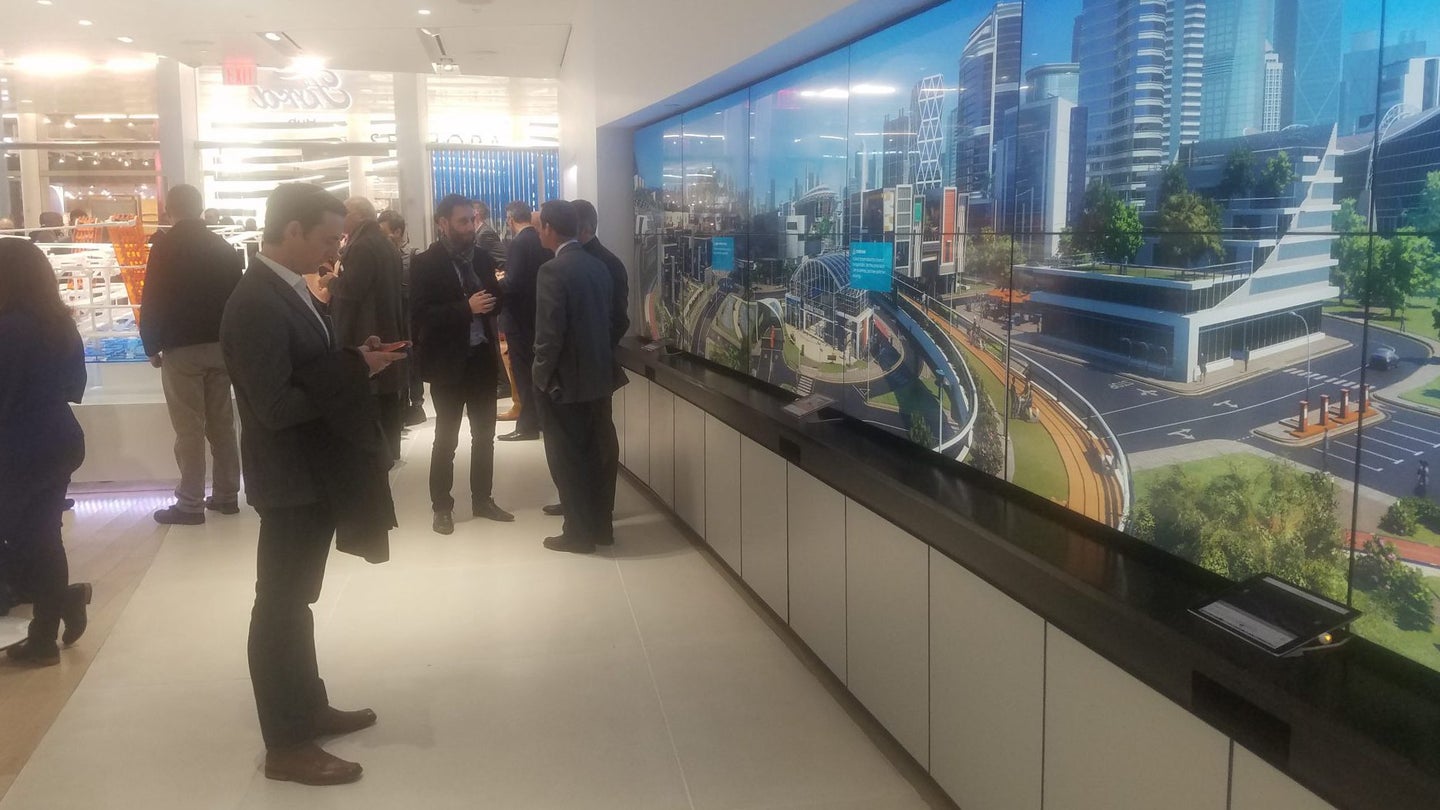Ford Unveils FordHub in Heart of NYC’s World Trade Center
Ford’s new “brand experience studio” sells tourists—and, possibly, New Yorkers—on the company. Cars? Not part of the equation.

Between neck-craning tourists and a daily crush of 300,000 commuters at the World Trade Center’s $3.9-billion train station, Ford is hoping you’ll visit its own, more modest transportation hub. Perhaps counterintuitively, the company promises it won’t try to sell you a Mustang.
The automaker opened its first FordHub on Monday, an “interactive brand experience studio” in the subterranean Westfield World Trade Center mall below the Oculus. The Oculus is the controversial train station’s centerpiece, a hyperbolic 160-foot sculpture that recalls either a freed bird—the take of Spanish architect Santiago Calatrava, who designed the space—or the bleached bones of Moby Dick.
“This isn’t a store or a dealer—it’s a place for participation and creativity,” said Elena Ford, vice-president of global dealer and consumer experience. “We want people to have fun while engaging in a conversation about the future of transportation.”
Ford CEO Mark Fields: No to immigration ban, yes to futuristic transportation
Monday’s conversation brought Mark Fields, Ford’s chief executive, to a discussion on the 102nd floor of One World Observatory. Surrounded by panoramic views of Manhattan and New Jersey—and visible traffic snarls of teensy cars—Fields reiterated Ford's opposition to President Trump's immigration ban. He also reprised his recent City of Tomorrow pitch on Ford’s role in urban mobility.
On track with those efforts, including Ford’s Chariot ride-sharing shuttles and bicycle rentals in San Francisco, FordHub looks to highlight the company’s reinvention as a mobility provider, not simply a traditional automaker. All this Kumbaya on the utopian transportation future can seem at odds with Ford’s and Detroit’s main business, which currently consists of peddling as many fuel-thirsty SUV’s and pickup trucks as possible. And Fields affirmed that selling cars and trucks will remain the core business of the 104-year-old company founded by Henry Ford.
“But if we stick our heads in the sand, we won’t be around for another 100 years,” Fields said of the need to innovate and adapt.
Housed in the WTC mall, next door to Tumi luggage and across from Sephora and Under Armour, the FordHub seeks to cast the company in a greener, benign light, especially in traffic- or pollution-choked cities: Part of the transportation solution, rather than the problem. "Ford Guides" will be on hand to field questions on mobility and, of course, any Ford product you might be interested in.
The FordHub is dominated by huge, loosely “interactive” screens of the type you find in airport concourses. There’s a mobility map of real-time traffic information on New York’s trains and ferries. Visitors can stand on wobbleboards and race through a clean-scrubbed onscreen cityscape that looks more like a 22nd-century Plano, Texas than Manhattan.
The only mildly intriguing attraction, so far, was “Mustang Over Manhattan,” which lets visitors strap on an HTC virtual headset, ride to the top of a virtual-reality Empire State Building and cobble a few Mustang chunks together. It's based on a 1965 publicity stunt, repeated in 2014, that saw Ford disassemble a Mustang, send the parts up elevators, and reassemble it atop the Empire State Building's observation deck in the pre-dawn hours. (It was still more realistic when I journeyed to the top of the freezing, wind-whipped skyscraper in real life to watch Ford engineers pull off the feat).
To use the in-vogue parlance, it’s all about the Brand Experience. But do people really want to “experience” a brand, as opposed to just buying and using its products—especially if the experience is canned or blatantly self-serving? The big question is whether many passersby will pop in and play along with the earnest brand messaging, or treat the FordHub like an unwanted Internet pop-up. Ford’s white-walled space feels antiseptic and not especially welcoming, especially compared with the more elegantly designed, coffee-peddling Cadillac House in SoHo. Caddy’s own brand studio also keeps a few vintage and showroom models on hand for car fans; the much-smaller FordHub might struggle to mount similar displays.
Ford's brand atelier must compete for attention with not only 100-some retailers in the 280,000 square-foot WTC mall, but a wealth of nearby attractions that includes the WTC Observatory and the September 11 Memorial and Museum. On the upside, tens of thousands of train riders will pass by Ford’s blue-ovaled doors every day, even if many of those are beelining to work or popular destinations. Ford does see the Hub as a dynamic, malleable space, and it plans to engage with “thought leaders,” artists and interested communities to create new interactive programs.
To my eye, the company had better get on it: If Ford doesn’t come up with more compelling attractions, the Hub will definitely become a new Manhattan gathering place—for dust, and bored tourists from Idaho.
